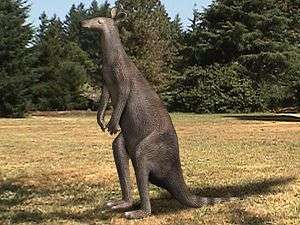Protemnodon
| Protemnodon[1] Temporal range: Pliocene-Pleistocene | |
|---|---|
 | |
| Artist's conception, Protemnodon anak | |
| Scientific classification | |
| Kingdom: | Animalia |
| Phylum: | Chordata |
| Class: | Mammalia |
| Infraclass: | Marsupialia |
| Order: | Diprotodontia |
| Family: | Macropodidae |
| Subfamily: | Macropodinae |
| Genus: | †Protemnodon Owen, 1873 |
| Paleospecies | |
|
†P. otibandus | |
Protemnodon is a genus of megafaunal macropods that existed in Australia, Tasmania, and Papua New Guinea in the Pliocene and Pleistocene. Based on fossil evidence, Protemnodon is thought to have been physically similar to wallabies, but far larger; Protemnodon hopei was the smallest in the genus, weighing about 45 kg, the other species all weighing over 110 kg.[2] Recent analysis of mtDNA extracted from fossils indicates that Protemnodon was closely related to Macropus.[3]
References
| Wikimedia Commons has media related to Protemnodon. |
- ↑ Haaramo, M. (20 December 2004). "Mikko's Phylogeny Archive: Macropodidae - kenguroos". Archived from the original on 31 March 2007. Retrieved 15 March 2007.
- ↑ Helgen, K.M., Wells, R.T., Kear, B.P., Gerdtz, W.R., and Flannery, T.F. (2006). "Ecological and evolutionary significance of sizes of giant extinct kangaroos". Australian Journal of Zoology. 54 (4): 293–303. doi:10.1071/ZO05077.
- ↑ Llamas, B.; Brotherton, P.; Mitchell, K. J.; Templeton, J. E. L.; Thomson, V. A.; Metcalf, J. L.; Armstrong, K. N.; Kasper, M.; Richards, S. M.; Camens, A. B.; Lee, M. S. Y.; Cooper, A. (2014-12-18). "Late Pleistocene Australian marsupial DNA clarifies the affinities of extinct megafaunal kangaroos and wallabies". Molecular Biology and Evolution. 32: 574–584. doi:10.1093/molbev/msu338. PMID 25526902.
This article is issued from
Wikipedia.
The text is licensed under Creative Commons - Attribution - Sharealike.
Additional terms may apply for the media files.